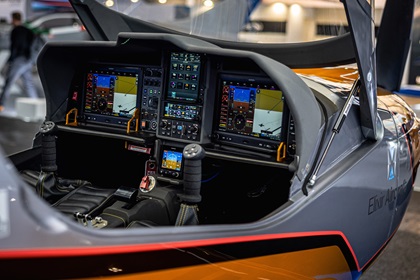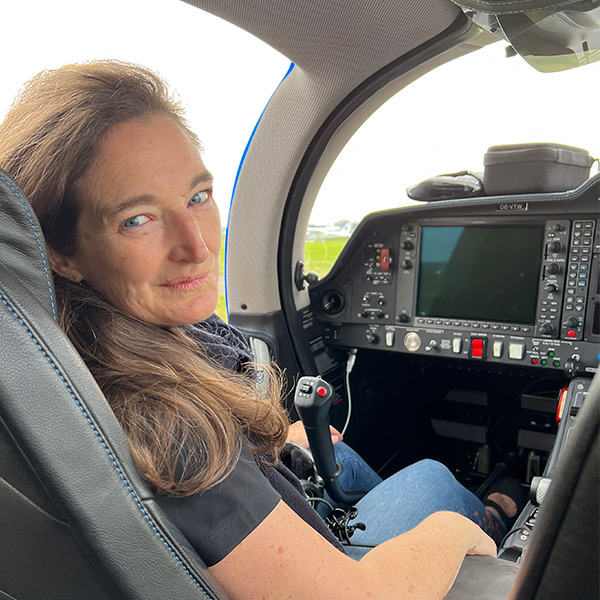Power alternatives at Aero 2024
Necessity incubates invention—and Aero Friedrichshafen, general aviation’s major show in Germany, proves the point in spades.
I’ve found over the past 14 years I’ve attended that this show has consistently hosted more innovation than most —and it does so in an approachable way, both for pilots and companies attending. The hub around which the most enticing developments have turned in 2024? Alternative sources of power. None of the top announcements involved traditional aircraft burning 100LL.
- Slovenia-based Gogetair’s lineup includes the G750 powered by the Rotax 912iS, 915iS, or 916iS—models able to run on automotive fuel—plus an experimental version using Turbotech’s 140-horsepower lightweight turbine. Though I haven’t flown it yet, colleagues in France have remarked upon its crisp handling and good performance at each horsepower level.
- BRM Aero has partnered with H55 on its electric aircraft bid, the Bristell B23 Energic. The Switzerland-based H55 takes lessons learned from the Solar Impulse, the first aircraft to fly around the world on solar-electric power. André Borschberg, pilot of the Solar Impulse, remains a principal of H55, and the powertrain developed for solar circumnavigation finds a good marriage with the sleek Bristell B23 airframe—a proven one from the Czech manufacturer.
- The two-seat Diamond eDA40 looks at first like its combustion-powered DA40 brethren—until you note the belly pod housing the 80-kilowatt bank of batteries in the EPiC power bank required to deliver juice to the Safran ENGINeUS 100 motor up front. The Austria-based manufacturer plans to make the design upgradable as new battery technology increases energy density every few years.
 Elixir’s 100-horsepower Rotax 912 model hits a training niche as well, with two-thirds of its order book assigned to the 100-knot two-seater going into flight schools. The remainder have been ordered by private owners and flying clubs, mostly in the 140-horsepower Rotax 915-powered version. The French aircraft manufacturer is expanding its factory in Aytré (near La Rochelle airport), and it recently signed a partnership to develop a reassembly base and service center in Sarasota, Florida.
Elixir’s 100-horsepower Rotax 912 model hits a training niche as well, with two-thirds of its order book assigned to the 100-knot two-seater going into flight schools. The remainder have been ordered by private owners and flying clubs, mostly in the 140-horsepower Rotax 915-powered version. The French aircraft manufacturer is expanding its factory in Aytré (near La Rochelle airport), and it recently signed a partnership to develop a reassembly base and service center in Sarasota, Florida.- Turbotech also showed off its re-engined Bristell XL8 with the 130-horsepower TP-R90 turbine—with a 3,000-hour time between overhaul—powering the two-seat personal airplane. Using a patented heat exchanger, the 100-kilowatt turboprop installation burns only 19 liters per hour (just over 5 gph) of Jet A in economy cruise.
- Also Rotax-powered, Shark Aero’s snazzy array of two-seat side-by-side and tandem-seat models feature the application of “turbulence cancelling” provided by Turbulence Solutions. The system uses a probe to detect minute and instantaneous changes in the relative wind vector and actuates automated flaplets on the wings to counteract the gusts. The simulation at Shark Aero’s booth was impressive—to me it feels similar to the active winglet technology now FAA certified by Tamarack Aerospace Group on Cessna Citation CJ series jets and Beechcraft King Air turboprops.
Moving up
The multiengine crowd has not been left behind either. Tecnam Aircraft announced its latest green take on an already environmentally friendly twin with the new P2006T NG, powered by a pair of advanced Rotax 912iS3s that sip 14 liters per hour (3.7 gph) per side for a range of up to 930 nautical miles. Launch customer FlyBy Aviation Academy plans to bring the P2006T NG onto its flight line in Burgos, Spain.
VoltAero brought its Cassio S testbed aircraft for demonstration during the “e aircraft” portion of the airshow on April 20, marking its first appearance at Aero. Utilizing an electro-hybrid powertrain by Safran and Kawasaki Motors, Cassio arrives fresh from its 220 flights thus far, covering a total of 10,000 kilometers and landings at more than 40 airports. For the show, it flew on a sustainable aviation fuel crafted from bioethanol produced with waste material from vineyards in France. Santé!
Moving further up the chain in size, the regional market addressed by Aura Aero’s ERA (electric regional aircraft) answers short-haul commercial transportation needs so prevalent in the European Union and nominally covered by train service in most markets—though Friedrichshafen’s current rail access proves the point that not all trains go where you want them to, and the untethering provided by air—whether via commercial service or GA—proves its worth time and again.
Aura has begun development toward the ERA with the two-seat Integral series—a seventh personal airplane entering the market, if you’re counting—starting with two fully aerobatic models, the nose-gear-fitted Integral S and the tailwheel Integral R. The company has two S prototypes flying, and it anticipates certification by the end of 2024, with the R following closely. A towplane version will fly in a few weeks, intended for the host of gliding clubs in France and Germany to start, though commercialization will be across Europe. The next step is an “E” version—electric—and the first flight of the prototype will take place by 2026, according to Jérémy Caussade, CEO of Aura Aero. The company expects it to achieve that certification in 2028.
The electric future? The hybrid present
I took some time at the show to talk with Tine Tomažič, chief engineer (and employee number 12) at Pipistrel about the evolution of the electric aircraft, which he has been an integral part of, shepherding the Alpha Electro, then the Velis Electro phase 1, and the current version (serial numbers 150 and later are those recently granted FAA LSA acceptance). “Every two to three years, we see the next step forward, which you can translate to either increased range or increased airspeed,” said Tomažič. That’s why Pipistrel’s Panthera was envisioned as a hybrid-electric airplane. That fuel flexibility suits the typical cross-country mission, as well as supporting a cruise speed (200 knots) that’s twice as fast as the Velis trainer at 100 knots.
In my mind, this acknowledgment demonstrates a practical approach to alternative power sources, and plenty of momentum to improve thermal combustion engines as we anticipate the next generation of battery capacity and the complex integration of highly energized systems into our aircraft. In fact, manufacturers like Continental Aerospace and Diamond’s Austro Engines continue to develop powerplants burning diesel—Jet A in the United States—with plenty of uptake by aircraft manufacturers, both fixed-wing and rotorcraft. Continental’s new CD-170R launched at Aero this year, extending the full authority digital engine control-enabled CD-170 first produced in 2020 into helicopter applications. At a 7.9 gph fuel burn—and the ability to utilize sustainable aviation fuel—it makes for a green-powered future that’s achievable now.




